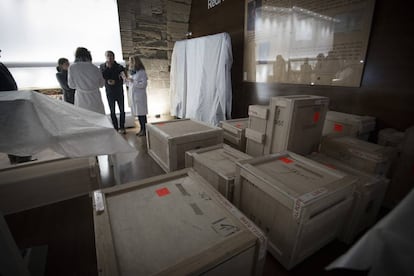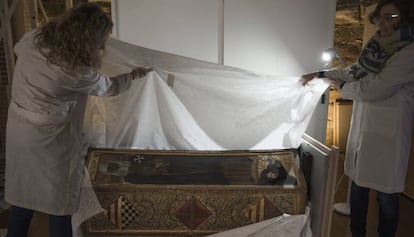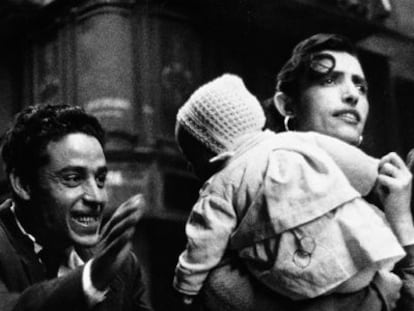What will become of the Sijena spoils?
Uncertainty remains over future of religious artifacts removed recently from Catalan museum


Sister Encielada welcomes us to the Monastery of Santa María de Sijena in the region of Aragon. This is the convent where Sancha of Castile, Queen of Aragon, lies in her mysteriously decorated tomb. Visitors are warned to be aware of falling debris and, though there is a ubiquitous chirping of birds, the cold us mind-numbing.
“We pray, but we freeze,” whispers the Sister, who appears to be in her twenties.
When asked about the return of the religious art sold off illegally sold off by the nuns of the Order of Knights of the Hospital of Saint John of Jerusalem over the course of a century, she replies, “Ah, now. That has nothing to do with us.”

Well, it does or it almost certainly will do soon. The Sijena artifacts are currently lying in boxes in the huge warehouse of this beautiful convent dating back to 1183. In the past two weeks since Huesca’s High Court rejected the Catalonian Government’s appeal and ordered the last of the artifacts to be returned from the Lleida Diocese Museum, experts have been opening the boxes and unwrapping the artworks responsible for the worst wrangle involving politics and heritage for over 100 years. However, further action brought by the Catalan government is yet to be addressed before the matter can be considered definitively closed.
The collection includes alabaster reliefs from the 16th century, mortuary chests from the 15th century, religious paintings from the 17th and 18th centuries and polychrome Mudéjar doors. Their sale to the Catalan government began at the end of the 19th century and continued until 1994, despite the fact the nuns had abandoned the monastery in 1970.
Competing ownership claims
Curator Laura Asín gets up and stares with excitement at Isabel of Aragon’s coffin. It’s one of the pieces that was on show in the Lleida Museum until the early hours of Monday, December 11, when it was removed by the National Guard and the regional Mossos d’Esquadra police in compliance with a court order issued in Huesca in 2015 and upheld at the end of November this year.
Asín, head of the Aragon government’s office for the promotion of cultural heritage, archives, museums and libraries, explains: “Because of certain legalities, we still can’t begin on the restoration of the pieces.”
The treasure is currently in the hands of the Aragon government, but its owner is still to be established. “Our lawyers say that the actions brought by the Catalan government won’t come to anything,” says a spokesman for the Aragon government’s Department of Culture. “But…”
Meanwhile, the director of the Lleida Museum, Josep Giralt who has demanded the power to inspect the conditions in which the pieces are being kept in Sijena, has said, “I am convinced that the Supreme Court will rule on our side and that the pieces will be returned to Lleida Museum.”

In response, Laura Asín says, “Well I would have liked to have inspected Lleida Museum before removing the pieces, but they wouldn’t let us.”
Ana Armillas, director of Aragon’s Huesca Museum, also participated in the removal of the art from Lleida. “It was very tense and sad,” says Armillas. “It was a difficult night and putting ourselves in the shoes of our colleagues in Lleida, it must have been hard. Some of them were crying as the pieces left the museum, just as we cried when they arrived in Sijena.”
While experts and politicians continue to clash over the cache, locals in Villanueva de Sijena are rubbing their hands with glee. “It’s great news,” says María Jesús, owner of La Bodega, the sole restaurant in this village of 400 people. “When the first pieces arrived in the summer of 2016, buses rolled in on Saturday and Sunday and we were full all weekend.”
The jewel in the crown
Should the court dismiss the actions brought by the Catalan government, the nuns now inhabiting the Sijena monastery from the orders of Belén, San Bruno and Asunción de la Virgen will be given the right to exhibit not only the art but the monastery too, which is a work of art in itself. Already Zaragoza-based architect studio Pemán and Franco is working on a museum project to this end. “They will have to extend visiting hours to allow people to see the monastery,” says the mayor of Villanueva, Ildefonso Salillas, who believes that the judge’s ruling in Huesca left no room for appeal.
Currently, the Sijena monastery only allows groups of 25 to visit on Saturday mornings but it will admit any lost souls who turn up on the doorstep. In the case of the latter, Sister Encielada shows them right in, since this is still in no man’s land just like the treasure that is all but repatriated.
English version by Heather Galloway.
Tu suscripción se está usando en otro dispositivo
¿Quieres añadir otro usuario a tu suscripción?
Si continúas leyendo en este dispositivo, no se podrá leer en el otro.
FlechaTu suscripción se está usando en otro dispositivo y solo puedes acceder a EL PAÍS desde un dispositivo a la vez.
Si quieres compartir tu cuenta, cambia tu suscripción a la modalidad Premium, así podrás añadir otro usuario. Cada uno accederá con su propia cuenta de email, lo que os permitirá personalizar vuestra experiencia en EL PAÍS.
¿Tienes una suscripción de empresa? Accede aquí para contratar más cuentas.
En el caso de no saber quién está usando tu cuenta, te recomendamos cambiar tu contraseña aquí.
Si decides continuar compartiendo tu cuenta, este mensaje se mostrará en tu dispositivo y en el de la otra persona que está usando tu cuenta de forma indefinida, afectando a tu experiencia de lectura. Puedes consultar aquí los términos y condiciones de la suscripción digital.
More information
Archived In
Últimas noticias
Maduro pleads not guilty before the federal court in New York: ‘I am still the president of Venezuela’
A new test can detect Alzheimer’s from a finger prick
UN team enters Sudanese city of El Fasher after paramilitary massacre: ‘It’s like a ghost town’
A recipe for resistance: Indigenous peoples politicize their struggles from the kitchen
Most viewed
- Gilles Lipovetsky: ‘If you want to live better and fall in love, take Prozac, don’t look to philosophy’
- Alain Aspect, Nobel laureate in physics: ‘Einstein was so smart that he would have had to recognize quantum entanglement’
- Maduro’s downfall puts China’s relationship with Venezuela to the test
- Why oil has been at the center of Venezuela-US conflicts for decades
- Alvin Hellerstein, a 92-year-old judge appointed by Bill Clinton, to preside over Maduro’s trial in New York










































